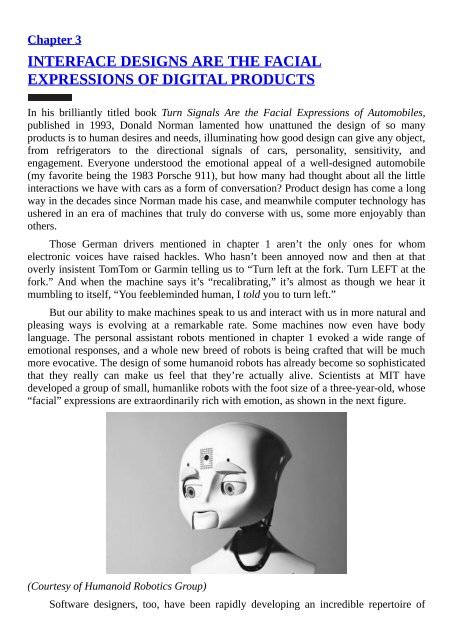Create successful ePaper yourself
Turn your PDF publications into a flip-book with our unique Google optimized e-Paper software.
Chapter 3<br />
INTERFACE DESIGNS ARE THE FACIAL<br />
EXPRESSIONS OF DIGITAL PRODUCTS<br />
In his brilliantly titled book Turn Signals Are the Facial Expressions of Automobiles,<br />
published in 1993, Donald Norman lamented how unattuned the design of so many<br />
products is to human desires and needs, illuminating how good design can give any object,<br />
from refrigerators to the directional signals of cars, personality, sensitivity, and<br />
engagement. Everyone understood the emotional appeal of a well-designed automobile<br />
(my favorite being the 1983 Porsche 911), but how many had thought about all the little<br />
interactions we have with cars as a form of conversation? Product design has come a long<br />
way in the decades since Norman made his case, and meanwhile computer technology has<br />
ushered in an era of machines that truly do converse with us, some more enjoyably than<br />
others.<br />
Those German drivers mentioned in chapter 1 aren’t the only ones for whom<br />
electronic voices have raised hackles. Who hasn’t been annoyed now and then at that<br />
overly insistent TomTom or Garmin telling us to “Turn left at the fork. Turn LEFT at the<br />
fork.” And when the machine says it’s “recalibrating,” it’s almost as though we hear it<br />
mumbling to itself, “You feebleminded human, I told you to turn left.”<br />
But our ability to make machines speak to us and interact with us in more natural and<br />
pleasing ways is evolving at a remarkable rate. Some machines now even have body<br />
language. The personal assistant robots mentioned in chapter 1 evoked a wide range of<br />
emotional responses, and a whole new breed of robots is being crafted that will be much<br />
more evocative. The design of some humanoid robots has already become so sophisticated<br />
that they really can make us feel that they’re actually alive. Scientists at MIT have<br />
developed a group of small, humanlike robots with the foot size of a three-year-old, whose<br />
“facial” expressions are extraordinarily rich with emotion, as shown in the next figure.<br />
(Courtesy of Humanoid Robotics Group)<br />
Software designers, too, have been rapidly developing an incredible repertoire of


